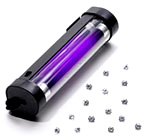Diamond Colour
While diamonds can be found in almost every colour of the rainbow, colourless diamonds remain the most popular.
When describing the colour of a diamond reference is being made to the degree of colour found in that diamond. The less colour displayed in a diamond the better the colour grade. The notable exception to this would be in the case of fancycoloured diamonds, such as pink, yellow, green and blue. In fancy coloured diamonds a strong presence of colour would improve the diamond’s colour grading and value.
Diamonds displaying little colour will absorb less white light, allowing more light to pass through, creating the Newton’s prism effect, with its spectrum of colours and flash, this fire and sparkle, is technically known as Dispersion.


Dispersion in Diamond

Critical Angle Refraction
Diamonds are allocated a grade according to the level or intensity of colour they possess. This grading is alphabetical, starting with a D grade given to completely colourless diamonds, the scale moves through E, F, G, etc down the alphabet indicating diamonds with progressively larger amounts of colour tinting, ending in a Z+ grade.
The colour grades can be described as follows:
D, E & F grades:
These are colourless diamonds. Only experienced diamond graders are capable of differentiating between D & E colours, and then only if these diamonds are un-mounted. Diamond graders can more consistently identify F colour diamonds.
G, H & I grades:
These are near colourless diamonds, and very often appear colourless when mounted and graded face up. Non- diamond graders will not be able to detect colour in these diamonds
J, K, L & M grades:
Most consumers will be able to identify a colour tint in these diamonds, when mounted. However when these diamonds weigh less then half a carat and are mounted in white metal, they may still appear as colourless. The average consumer will be able to detect a subtle presence of colour tinting around the J grade where a very-light yellow or brown tones may be identified becoming more pronounced towards the M.
O –Z grades:
Most consumers will be quick to notice colour in these diamonds, regardless of how the diamond is mounted. These diamonds will range between a dark uninspiring murky yellows, browns and greys.

What to consider when deciding on your diamond’s colour:
Where your setting is in yellow gold you may be able to chose a lower colour grade than if you were choosing a platinum or white gold setting;
Yellow shades, found in K-M graded diamonds, may draw out the latent character of a jewellery piece.
I would suggest that if a budget is being watched then consider selecting your Diamond from the very acceptable G, H and I colour grades.
A word on fluorescence
Fluorescence is the reaction of some diamonds to exposure in long or short wave ultraviolet light. Fluorescence is visible in shades of yellow, green or blue and can make clear diamonds appear as cloudy and yellow tinted Diamonds appear as whiter. Ideal situations to view Fluorescence would be either in strong sunlight or the Night club scene. Under normal lighting conditions and standard daylight Fluorescence is not normally detectable.
The amount or strength of Fluorescence will vary greatly from Diamond to Diamond, from a pale almost invisible glow up to an illuminating bright light. Fluorescence is noted on most Diamond Certificates and will be graded from faint up to very strong.

Ultraviolet Lamp

Rough Diamonds showing
fluorescence
The presence or absence of Fluorescence should be considered as part of the purchasing decisions by all diamond buyers. It is a very intriguing phenomenon when viewed, especially if your Diamond has strong Fluorescence as it becomes a talking point.
Imagine being on holiday with your New Engagement Ring, sitting by the pool enjoying the strong sunlight, picking up that well earned tan and your Diamond changes from a stunning sparkling white Gem into a cloudy bright sky blue stone akin to a Murky Ceylon Sapphire. What a shock the first time you see it. No, the presence of Fluorescence is not for everyone, maybe better avoided from the outset. As part and parcel of the valuing process, diamonds with noticeable Fluorescence will cost progressively less.
The bottom line about fluorescence
A D-colored diamond (the highest color) with very strong fluorescence may display a “haze” or “cloudiness” that detracts from the overall luster of the stone. However, diamonds exhibiting fluorescence especially those diamonds with lower colors like I or J may seem more white and give the appearance of being G-color or H-color diamonds. Since the diamond trade still undervalues diamonds with any fluorescence in the colorless color-grades (D through F), customers may obtain a diamond at a relative bargain when buying one with faint or even medium fluorescence. For excellent value in a diamond with no noticeable color to the unaided eye, look for near-colorless grades of G-color through J-color, and a fluorescence grade of medium or strong blue.
The diamonds below are exposed to a strong Ultraviolet light source. The intensity is identical for each photograph. All of these diamonds are colourless.

Diamond with no
fluorescence

Diamond with faint
fluorescence

Diamond with medium
fluorescence

Diamond with strong
fluorescence
Note: On GIA and other diamond grading reports, a diamond’s fluorescence may be described as ‘None’. My clients should be aware that ‘None’ on these reports specifically means “Less than Faint”, and does not necessarily indicate “Absolutely No” fluorescence that one would rationally assume.

